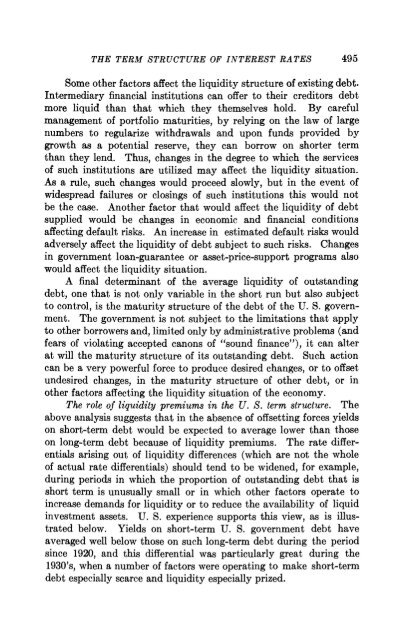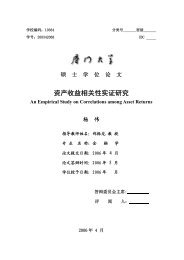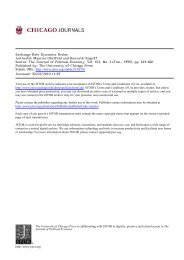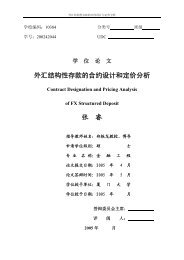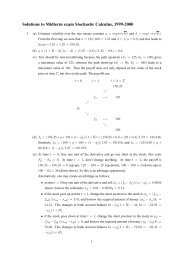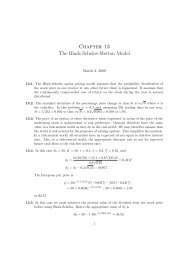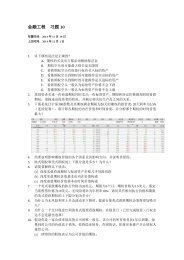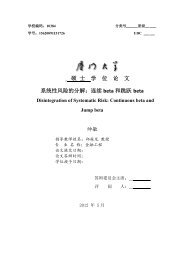The Term Structure of Interest Rates
The Term Structure of Interest Rates
The Term Structure of Interest Rates
You also want an ePaper? Increase the reach of your titles
YUMPU automatically turns print PDFs into web optimized ePapers that Google loves.
THE TERM STRUCTURE OF INTEREST RATES 495<br />
Some other factors affect the liquidity structure <strong>of</strong> existing debt.<br />
Intermediary financial institutions can <strong>of</strong>fer to their creditors debt<br />
more liquid than that which they themselves hold. By careful<br />
management <strong>of</strong> portfolio maturities, by relying on the law <strong>of</strong> large<br />
numbers to regularize withdrawals and upon funds provided by<br />
growth as a potential reserve, they can borrow on shorter term<br />
than they lend. Thus, changes in the degree to which the services<br />
<strong>of</strong> such institutions are utilized may affect the liquidity situation.<br />
As a rule, such changes would proceed slowly, but in the event <strong>of</strong><br />
widespread failures or closings <strong>of</strong> such institutions this would not<br />
be the case. Another factor that would affect the liquidity <strong>of</strong> debt<br />
supplied would be changes in economic and financial conditions<br />
affecting default risks. An increase in estimated default risks would<br />
adversely affect the liquidity <strong>of</strong> debt subject to such risks. Changes<br />
in government loan-guarantee or asset-price-support programs also<br />
would affect the liquidity situation.<br />
A final determinant <strong>of</strong> the average liquidity <strong>of</strong> outstanding<br />
debt, one that is not only variable in the short run but also subject<br />
to control, is the maturity structure <strong>of</strong> the debt <strong>of</strong> the U. S. government.<br />
<strong>The</strong> government is not subject to the limitations that apply<br />
to other borrowers and, limited only by administrative problems (and<br />
fears <strong>of</strong> violating accepted canons <strong>of</strong> "sound finance"), it can alter<br />
at will the maturity structure <strong>of</strong> its outstanding debt. Such action<br />
can be a very powerful force to produce desired changes, or to <strong>of</strong>fset<br />
undesired changes, in the maturity structure <strong>of</strong> other debt, or in<br />
other factors affecting the liquidity situation <strong>of</strong> the economy.<br />
<strong>The</strong> role <strong>of</strong> liquidity premiums in the U. S. term structure. <strong>The</strong><br />
above analysis suggests that in the absence <strong>of</strong> <strong>of</strong>fsetting forces yields<br />
on short-term debt would be expected to average lower than those<br />
on long-term debt because <strong>of</strong> liquidity premiums. <strong>The</strong> rate differentials<br />
arising out <strong>of</strong> liquidity differences (which are not the whole<br />
<strong>of</strong> actual rate differentials) should tend to be widened, for example,<br />
during periods in which the proportion <strong>of</strong> outstanding debt that is<br />
short term is unusually small or in which other factors operate to<br />
increase demands for liquidity or to reduce the availability <strong>of</strong> liquid<br />
investment assets. U. S. experience supports this view, as is illustrated<br />
below. Yields on short-term U. S. government debt have<br />
averaged well below those on such long-term debt during the period<br />
since 1920, and this differential was particularly great during the<br />
1930's, when a number <strong>of</strong> factors were operating to make short-term<br />
debt especially scarce and liquidity especially prized.


